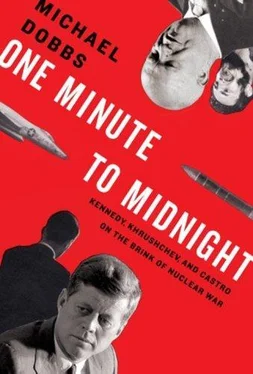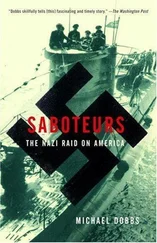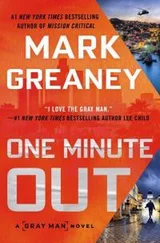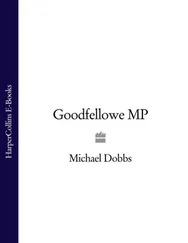“missiles flying through”: Council for Correspondence, Newsletter No. 22, Herman Kahn files, NDU; author’s interview with Irvin Doress, February 2006.
When the military radar station: Charts of Maultsby flight.
Earlier in the week: Author’s interviews with former F-102 pilots Leon Schmutz and Joseph W. Rogers, June 2003. See also Sagan, 136-7; Alaskan Air Command Post log, October 22, 1962.
“Khrushchev, like every doctrinaire”: Message to Joint Staff from Maj. Gen. V. H. Krulak, October 26, 1962, JCS Maxwell Taylor records, NARA.
“diplomatic blackmail”: JCS memo for the President, JCSM-844-62, OSD.
“Attacking Sunday or Monday”: JCS Poole notes.
“much worse if Khrushchev”: Kaplan, 256.
“You must have lost”: David Burchinal OH, NSAW Cuba.
“the ablest combat officer”: McNamara interview; see also McNamara interviews for The Fog of War, film documentary, directed by Errol Morris (Sony Pictures Classics, 2003).
He slept on a cot: LAT, October 28, 1962; McNamara desk diaries, OSD.
“A U-2 has been lost”: JCS Poole notes. In his 1975 oral history, Burchinal claimed that McNamara yelled hysterically, “This means war with the Soviet Union. The president must get on the hot line to Moscow!” McNamara denies saying this. The Moscow-Washington “hot line” was inaugurated after the missile crisis.
“got off course”: Secret U-2 memo, National Security Files, Box 179, JFKL.
Returning from his swim: I have reconstructed events from the president’s telephone logs for October 27, 1962; the White House gate logs, JFKL; and O’Donnell and Powers, Johnny, We Hardly Knew Ye, 338-9. The latter account confuses the timing of when JFK found out about the two U-2 incidents.
“There’s always some sonofabitch”: Roger Hilsman, To Move a Nation (Garden City, NY: Doubleday, 1967), 221; JFK letter to Jacqueline Kennedy, March 6, 1964, JFKL; Roger Hilsman interview, CNN CW.
“the last time I asked”: According to O’Donnell and Powers, 337, JFK had “ordered the removal of the Jupiter missiles in August.” Bundy later disputed this claim, arguing that “a presidential opinion is not a presidential order”—see Stern, 86. A presidential memorandum (NSAM 181) dated August 23, 1962, tasked the Pentagon with examining “what action can be taken to get Jupiter missiles out of Turkey”—see Nash, 110.
“the people deciding”: Parallel drawn by Stern, 39, 296.
“The possibility of the destruction”: RFK, 127, 106.
“You might as well come back”: Herman interview; History of the 4080th Strategic Wing, October 1962, FOIA.
He personally got on the phone: Author’s interview with McNamara military aide Sidney B. Berry, May 2006.
“operating on the basis”: Gilpatric OH, NSAW.
He ordered its immediate recall: History of the 4080th Strategic Wing, October 1962, FOIA; McNamara memo to Air Force secretary, October 28,1962, OSD.
“A U-2 overflying Cuba”: JCS Poole notes. The news was brought by Col. Ralph D. Steakley of the Joint Reconnaissance Group.
“Bail out!”: Maultsby memoir. Maultsby does not mention the name of the pilot who urged him to bail out. Schmutz says it was not him, so it must have been Rands, who has since died.
The U-2 “did not seem to want”: Maultsby calculated his flight time as 10 hours 25 minutes, a record for a U-2 flight. A White House note records his touchdown time as 2:14 p.m. Washington time after a 10-hour 14-minute flight—National Security Files, Box 179, JFKL. He was scheduled to return at 11:50 a.m. after a 7-hour 50-minute flight. I have used the time provided by Maultsby, which is also cited in the October 1962 History of the 4080th Strategic Wing.
CHAPTER TWELVE: “RUN LIKE HELL”
SAC already had more planes: Cuba Fact Sheet, October 27, 1962, NSAW.
the “last thing” Andrus wanted: Reminiscences of Col. Burton C. Andrus, Jr., History of the 341st Space Wing, FOIA.
“I hate these Krauts”: Joseph E. Persico, Nuremberg: Infamy on Trial (New York: Penguin, 1995), 50.
“Khrushchev knows we’re after”: Interview with Joe Andrew, Missile Maintenance Division, 341st Strategic Missile Wing, September 2005, in Time magazine, December 14, 1962.
“You can’t drive it”: Lt. Col. George V. Leffler quoted in Saturday Evening Post, February 9, 1963.
“If I don’t get a light”: Andrus reminiscences.
“have had warheads installed”: Eugene Zuckert letter to JFK, October 26, 1962, Curtis LeMay records, Manuscript Division, Library of Congress. Alpha Six was placed on strategic alert at 1816Z (2:16 p.m. Washington time) on October 26, 1962 (November history, 341st Strategic Missile Wing, Sagan Collection, NSAW).
“required many workarounds”: October history, 341st Strategic Missile Wing, Sagan Collection, NSAW; Sagan, 82-90.
Having encouraged Andrus: SAC Historical Study No. 90, Vol. 1, 72-3, 121; SAC message 1827Z, October 27, 1962.
and “run like hell”: Andrew interview in Time.
Two B-52 Stratofortresses: SAC Historical Study No. 90, Vol. 1, 43. During the missile crisis, B-52s generally carried either four Mark-28s or two Mark-15s.
“ready to go to war”: “A Full Retaliatory Response,” Air and Space (November
2005); author’s interviews with former SAC pilots Ron Wink and Don Aldridge, September 2005.
to deliver the “full retaliatory response”: Sagan, 66.
“Ocean Station Bravo”: SAC Historical Study No. 90, Vol. 1, 90. For jamming, see Air Force messages AF IN 1500 and 1838, October 27 and 28, CNO Cuba, USNHC.
six “target complexes”: Kaplan, 268.
the “dead man’s switch”: Sagan, 186-8.
The special storage facilities: CIA, Supplement 8, Joint Evaluation of Soviet Missile Threat, October 28, 1962, LBJ Library; Yesin interview.
Soviet missiles could not hit: My source for the targeting of New York from Calabazar is retired Col. Gen. Viktor Yesin, who served under Sidorov as a lieutenant engineer and had the opportunity to review archival documents closed to other researchers as chief of staff of the Soviet Strategic Rocket Forces.
“Don’t worry”: Malakhov notes, MAVI; Yesin interview.
The regiment was formally: Yesin interview.
Communications links with division headquarters: CIA, Supplement 8, Joint Evaluation of Soviet Missile Threat, LBJ Library.
“You have to understand”: Yesin interview.
The CIA had long suspected: CIA telegram on Communist plans for Central America in the event of an invasion of Cuba, October 10, 1962, National Security Files, JFKL; CIA memo on Cuban subversion, February 18, 1963, JFKARC.
On Saturday afternoon: Undated CIA memo obtained through CREST, RDP80B01676R001800010029-3; CIA memoranda, The Crisis: USSR/Cuba, October 29 and November 1, 1962; October 27, 1962, intercept, JFKARC.
“It is the duty of every revolutionary”: Blight et al., Cuba on the Brink, 18.
A secret plan known as Operation Boomerang: Blight and Welch, eds., Intelligence and the Cuban Missile Crisis, 99.
“The United States will not be able”: Fursenko and Naftali, One Hell of a Gamble, 141.
At the Mongoose meeting on Friday: CIA memo, “Operation Mongoose, Main Points to Consider,” October 26, 1962, and McCone memo on Mongoose meeting, October 26, 1962, JFKARC.
It did not take long: NYT, October 29, 1962.
a “Communist sabotage ring”: NYT, October 30, 1962.
Operation Bugle Call: Memos on CINCLANT psychological leaflet program, OSD. After initially supporting the operation, the Joint Chiefs described it as “militarily unsound” in an October 27 memorandum (OSD). The chiefs feared that the delivery aircraft might be shot down, providing the Cubans with a propaganda victory.
Читать дальше












